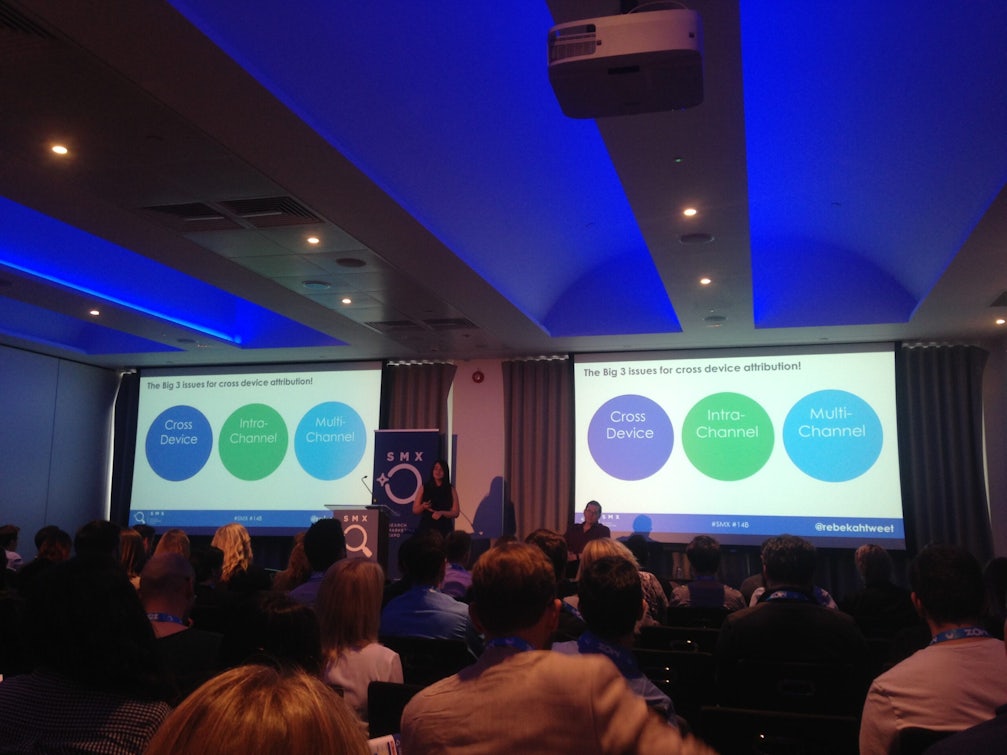Rebekah Schelfhout of Merkle | Periscopix opened by asking us to give our mobile phones to the person next to us. Nomophobia: the fear of being away from our mobile phones.
It’s the state of the UK today that we don’t want to be away from our phones. One screen usage has declined to just 13%, with more people showing a preference for multiple devices in their lives.
On average, each one of us interacts with our phones 2,617 a day. It’s connected to us 24/7 these days.
So, there are a few issues with cross device attribution:
- The consumer journey is complex. People can search anytime, anywhere, on any device
- 75% of journeys start on one device and finish on another
- Last click attribution modelling; when we use this, we are part of the problem
The issues we need to tackle are:
- Cross device
- Intra channel
- Multi channel
Each of these is managed individually, but there’s no one place to see everything.
The great thing is that almost all of the Google stack is using data driven attribution now.
The absolute winner for attribution is Attribution 360, but Google will be announcing Google Attribution, its own tool, later today.
What is counted as cross device conversion?
If someone goes onto mobile and then direct on desktop, it’s a cross device conversion.
If they come through a desktop, then tablet, then phone, it’s just a conversion.
Track everything!
Looking at macro conversions and well as micro conversions is an essential part of traffic. Even though micro conversions aren’t seen as revenue driving, they’re still, important parts of the user journey.
In addition to this, you should be using query strings to be able to track everything and be able to segment it later.
If you’re using AdWords, they pretty much have it nailed; to be able to see your attribution model and bid directly from it is awesome. They also recently announced that estimated conversions will play a bigger part in bid adjustments soon.
Which model?
Rebekah used the analogy of a night out. She had a pint of beer, a glass of wine and a shot of tequila. Her hangover the next day can’t be blamed on any one drink, but all.
So which model should we be using, if not first or last click?
Rebekah believes we should be using Google’s data driven attribution. Google’s machine learning tool goes in and attributes to every step of the journey to say how much each step has contributed.
Rebekah likes the dynamic algorithm, that keeps the model fluid and updates based on performance. The benefits of using this on AdWords is that it takes multi-devices into account, which isn’t the case across other models.
If you don’t qualify to use this model, try time decay, linear or position based.
Be sure to compare models in Analytics to see how the different models might change your decisions.
Assisting devices
The cross device assisting device report gives insight into how different devices contributed to conversions.
The device paths report in AdWords shows you the move from device to device in the path to conversion.
Adjust your model in the conversions tab
The great thing about AdWords is that you can actually change your attribution within the conversions tab, and set it up for each conversion type too, depending on use and business goal.
It’s really important to note that this is one of the only places we can change attribution models at the source and bid accordingly.
Using data stitching for a single customer journey
If you don’t have a tool which covers cross device tracking, you can use data stitching.
We need to move away from clicky based tracking to more user based tracking. That’s because with clicky tracking, we’d end up seeing three different clicks as three users.
But we can make them one.
If a use clicks on your website, they get a client ID. They then fill in a form and get a user ID.
When they login on a different device, they get a different client ID, but again, gather their information and tie that back into your CRM and the user ID.
We need to be really investing in cross device tracking, so we can make better informed decisions. Pick a model, stick to it and act on it, says Rebekah, so we can compare apples with apples.



